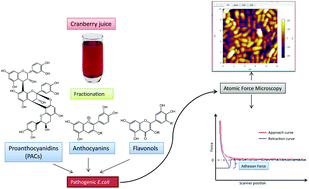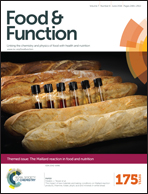Atomic force microscopy-guided fractionation reveals the influence of cranberry phytochemicals on adhesion of Escherichia coli
Abstract
Cranberry juice has been long used to prevent infections because of its effect on the adhesion of the bacteria to the host surface. Proanthocyanidins (PACs) comprise of one of the major classes of phytochemicals found in cranberry, which have been extensively studied and found effective in combating adhesion of pathogenic bacteria. The role of other cranberry constituents in impacting bacterial adhesion haven't been studied very well. In this study, cranberry juice fractions were prepared, characterized and tested for their effect on the surface adhesion of the pathogenic clinical bacterial strain E. coli B78 and non-pathogenic control E. coli HB101. The preparations tested included crude cranberry juice extract (CCE); three fractions containing flavonoid classes including proanthocyanidins, anthocyanins and flavonols; selected sub-fractions, and commercially available flavonol glycoside, quercetin-3-O-galactoside. Atomic force microscopy (AFM) was used to quantify the adhesion forces between the bacterial surface and the AFM probe after the treatment with the cranberry fractions. Adhesion forces of the non-pathogenic, non fimbriated lab strain HB101 are small (average force 0.19 nN) and do not change with cranberry treatments, whereas the adhesion forces of the pathogenic, Dr adhesion E. coli strain B78 (average force of 0.42 nN) show a significant decrease when treated with cranberry juice extract or fractions (average force of 0.31 nN, 0.37 nN and 0.39 nN with CCE, Fraction 7 and Fraction 4 respectively). In particular, the fractions that contained flavonols in addition to PACs were more efficient at lowering the force of adhesion (average force of 0.31 nN–0.18 nN between different sub-fractions containing flavonols and PACs). The sub-fractions containing flavonol glycosides (from juice, fruit and commercial quercetin) all resulted in reduced adhesion of the pathogenic bacteria to the model probe. This strongly suggests the anti adhesive role of other classes of cranberry compounds in conjunction with already known PACs and may have implications for development of alternative anti bacterial treatments.


 Please wait while we load your content...
Please wait while we load your content...